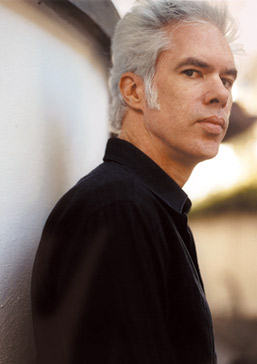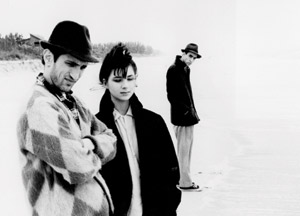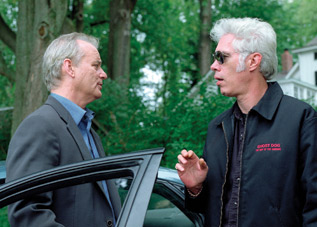BY ROB FELD
 (Photo Credit: Nicholas Guerin/Corbis)
(Photo Credit: Nicholas Guerin/Corbis)Before indie film was a brand, before black-clad studio execs migrated annually to Park City with their lawyers, there were filmmakers like Jim Jarmusch who, by hook or by crook, made movies. What, if anything, would happen to the films thereafter, nobody knew or even considered, but they were written, shot and assembled solely according to the vision of their makers. Since his first film, Permanent Vacation, made in 1980 as his NYU thesis project, Jarmusch is one of the few who has managed to maintain absolute authorial and even copyright control of his work, while making exactly the films he wants.
"There was no real focus on career opportunities [when I was starting out]," Jarmusch says, sitting in a coffee shop on Ludlow Street. "It was more love of the form. Even my inspiration then was the independent music scene. I spent a lot of time at Max's Kansas City and CBGB's. Those musicians were not striving to get hit records made or even get signed by major labels. They just wanted to express something, and it was picked up by painters and filmmakers from that whole scene."
New York was different then. That Jarmusch could live in a three-room apartment on Prince Street for $165 a month is testament to the freedom artists had to forgo financial concerns. Indie filmmakers, who were also part of the music scene, were able to rent a storefront on St. Mark's Place to show their work. "That was an inspiration to me," says Jarmusch. "They're now called punk rock or experimental films, but they were really do-it-yourself, guerrilla films, shot on the street by taking out car loans, or whatever. So I decided I was going to make a film, too, which was Permanent Vacation."
Though it was rejected by NYU as a thesis film for being too long, the film screened at the Mannheim-Heidelberg International Film Festival, where it won the Josef von Sternberg Award. Jarmusch was able to sell the film to German television and eventually recoup the $12,000 it cost to make. From there, he did it all again. With story ideas concocted with John Lurie, short-ends given to him by Wim Wenders - who Jarmusch met when he was Nicholas Ray's assistant at NYU - and encouragement from his future DP, Robby Müller, he shot Stranger than Paradise (1984) as a 30-minute short. With the script for the feature length version to accompany it, he raised money to finance the rest of the film from European television.
 INDIE SPIRIT: Jarmusch's inspiration was the music scene and
INDIE SPIRIT: Jarmusch's inspiration was the music scene and
"do-it-yourself, guerrilla films" in the late '70s. He made Stranger
than Paradise (1984) with money from European TV.
(Photo Credit: Photofest)The film won the Caméra d'Or at Cannes and was bought in territories around the world. "And I thought, maybe I could keep doing this," Jarmusch says. "Again, though, we were trying to make a film for ourselves that we would like. We were not at all conscious of the world of cinema commerce - and maybe we were naive. I was very lucky, too, partly being at the right place, right time. I think if we tried to make a film like that now, they'd laugh me out of the room. 'What the hell is this? Each scene is a single setup?' But that got me started."
Jarmusch was approached by studios offering coming-of-age teen comedies, which seemed to solidify not just his independent track creatively, but in business as well. "It really perplexed me because it was like they hadn't seen the film, just looked up how many times it was mentioned in the trades. So, I just discounted all of that and started writing a new script, which became Down by Law (1986). But I was learning. My lawyer on Stranger was Jim Stark, who said to me at the time, 'You know, you should own the rights to your films. Whatever you give away now, you give away forever. Own them and just license them.' And so I did."
Focus Features, which financed Jarmusch's first studio film, Broken Flowers (2005), was willing to license worldwide rights from him while respecting his ironclad rules of complete creative control and non-interference. "The definition of independent for me is having that creative control over the film. You have to have a strong backbone and be willing to walk away from things. It's easy for me because I don't have any problem walking away from something very lucrative that won't let me make the movie as I want. There's no choice at all, no hesitation."
 TWO OF A KIND: In Broken Flowers (2005), Jarmusch's biggest budget
TWO OF A KIND: In Broken Flowers (2005), Jarmusch's biggest budget
film, Bill Murray's deadpan acting complements the director's
static shooting style. (Photo Credit: David Lee)His willingness to walk away, and the desire of well-known actors like Bill Murray, who starred in Broken Flowers and Coffee and Cigarettes (2003), have afforded Jarmusch the freedom to develop a style and voice uniquely his own. His static camera and solidly composed shots are recognizable elements in his non-plot-oriented stories. "Obviously, I'm not a master of varied styles. Little things change for me depending on the story I'm telling and what style I feel is emotionally appropriate for it. I have a quiet, methodical approach to the camera, which allows the world the characters inhabit to resonate more than if you design your cuts to tell the viewer at every moment what is important by the framing or size on the screen. If you cut very quickly, then it's a different kind of music. I guess I like slower music."
Music is always a signature element of any Jarmusch film, and, like a jazz musician, he approaches his compositions with a structure that allows for improvisation. He never uses storyboards and has stopped using shot lists. "It's a very intuitive process. There's a lot of nuance that can only really be responded to with intuition, not a game plan. Thinking on your feet and engendering that with the crew keeps that spirit going."
As such, his projects follow their own rules, and Jarmusch has found the DGA's flexibility helpful in things like arranging credits and getting to work with ADs of his choice. "I like being protected and under the umbrella of a group of people whose craft is this particular profession. My spirit is that of an amateur - a lover of something. But what's great is that, in the DGA, I'm treated and looked after as a professional. Psychologically, that's invaluable to me."
Like many directors, Jarmusch brings a lot of the same people with him from film to film. "I try to keep a calm set," he says, "but I've seen my friend Abel Ferrara work in total chaos. I've been on a Fellini set in Italy, and watched him talk over the actors with a bullhorn, while they're speaking during the take. While he's setting up a shot on a dolly, no one speaks, no one moves, no one works. Then, he's ready. 'Okay, now we shoot,' and they're hammering, carrying scaffolding and walking around behind the camera, and he says, 'Si, si, va bene!' So everyone does it so differently and I find that fascinating."
At this point in his career, Jarmusch has left the pool of neophyte indie filmmakers contemplating their next move, but his advice to them remains the same as for himself. "I believe in the imagination. That's my religion. If you're making movies because you love them, then your first focus has to be on what you want to say, what you're doing with the form. Everything else is secondary. I can only talk about the way I do it and I'm uncomfortable giving advice, because as many filmmakers as there are, there should be that many ways to make a film."